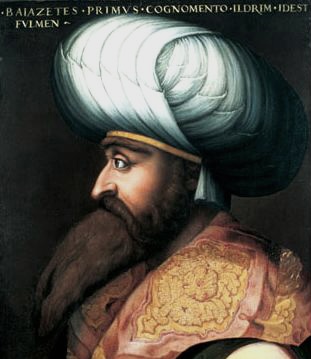
Bayezid I, also known as Bayezid the Thunderbolt, was the sultan of the Ottoman Empire from 1389 to 1402. He adopted the title of Sultan-i Rûm, Rûm being the Arabic name for the Eastern Roman Empire. In 1394, Bayezid unsuccessfully besieged Constantinople. In 1402, he once more besieged Constantinople, appearing to find success, but he ultimately withdrew due to the invasion of the Mongol conqueror Timur. He defeated the Crusaders at the Battle of Nicopolis in what is now Bulgaria in 1396. He was later defeated and captured by Timur at the Battle of Ankara in 1402 and died in captivity in March 1403, which triggered the Ottoman Interregnum.
Year 1395 (MCCCXCV) was a common year starting on Friday of the Julian calendar, the 1395th year of the Common Era (CE) and Anno Domini (AD) designations, the 395th year of the 2nd millennium, the 95th year of the 14th century, and the 6th year of the 1390s decade.

The Battle of Varna took place on 10 November 1444 near Varna in eastern Bulgaria. The Ottoman army under Sultan Murad II defeated the Crusaders commanded by King Władysław III of Poland and Hungary, John Hunyadi and Mircea II of Wallachia. It was the final battle of the unsuccessful Crusade of Varna, a last-ditch effort to prevent further Ottoman expansion into the Balkans.

Marko Mrnjavčević was the de jure Serbian king from 1371 to 1395, while he was the de facto ruler of territory in western Macedonia centered on the town of Prilep. He is known as Prince Marko and King Marko in South Slavic oral tradition, in which he has become a major character during the period of Ottoman rule over the Balkans. Marko's father, King Vukašin, was co-ruler with Serbian Tsar Stefan Uroš V, whose reign was characterised by weakening central authority and the gradual disintegration of the Serbian Empire. Vukašin's holdings included lands in north-western Macedonia and Kosovo. In 1370 or 1371, he crowned Marko "young king"; this title included the possibility that Marko would succeed the childless Uroš on the Serbian throne.

Mircea the Elder was the Voivode of Wallachia from 1386 until his death in 1418. He was the son of Radu I of Wallachia and brother of Dan I of Wallachia, after whose death he inherited the throne.

Vlad II, also known as Vlad Dracul or Vlad the Dragon, was Voivode of Wallachia from 1436 to 1442, and again from 1443 to 1447. He is internationally known as the father of Vlad the Impaler, or Dracula. Born an illegitimate son of Mircea I of Wallachia, he spent his youth at the court of Sigismund of Luxembourg, who made him a member of the Order of the Dragon in 1431. Sigismund also recognized him as the lawful Voivode of Wallachia, allowing him to settle in nearby Transylvania. Vlad could not assert his claim during the life of his half-brother, Alexander I Aldea, who acknowledged the suzerainty of the Ottoman Sultan, Murad II.

The rise of the Ottoman Empire is a period of history that started with the emergence of the Ottoman principality in c. 1299, and ended c. 1453. This period witnessed the foundation of a political entity ruled by the Ottoman Dynasty in the northwestern Anatolian region of Bithynia, and its transformation from a small principality on the Byzantine frontier into an empire spanning the Balkans, Anatolia, Middle East and North Africa. For this reason, this period in the empire's history has been described as the "Proto-Imperial Era". Throughout most of this period, the Ottomans were merely one of many competing states in the region, and relied upon the support of local warlords Ghazis and vassals (Beys) to maintain control over their realm. By the middle of the fifteenth century the Ottoman sultans were able to accumulate enough personal power and authority to establish a centralized imperial state, a process which was brought to fruition by Sultan Mehmed II. The conquest of Constantinople in 1453 is seen as the symbolic moment when the emerging Ottoman state shifted from a mere principality into an empire therefore marking a major turning point in its history.
Mircea II (1428–1447) was the Voivode, or prince, of Wallachia in 1442. He was the oldest son of Vlad II Dracul and brother of Vlad Țepeș and Radu the Handsome. He was the grandson of his namesake Mircea cel Bătrân.
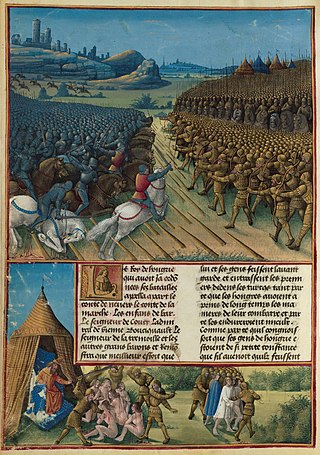
The Battle of Nicopolis took place on 25 September 1396 and resulted in the rout of an allied Crusader army of Hungarian, Croatian, Bulgarian, Wallachian, Polish, French, Burgundian, German, English, Knights Hospitaller, Iberian, Italian, Bohemian, Serbian and Byzantine troops at the hands of an Ottoman force, raising the siege of the Danubian fortress of Nicopolis and leading to the end of the Second Bulgarian Empire. It is often referred to as the Crusade of Nicopolis as it was one of the last large-scale Crusades of the Middle Ages, together with the Crusade of Varna in 1443–1444. By their victory at Nicopolis, the Turks discouraged the formation of future European coalitions against them. They maintained their pressure on Constantinople, tightened their control over the Balkans, and became a greater threat to Central Europe.
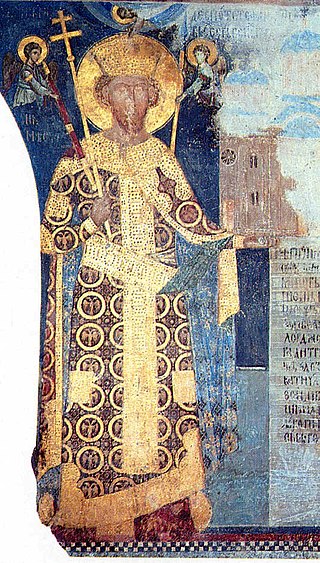
Stefan Lazarević, also known as Stefan the Tall, was a Serbian ruler as prince (1389-1402) and despot (1402-1427). He was also a diplomat, legislator, ktetor, patron of the arts, poet and one of the founding members of the Order of the Dragon. The son of Prince Lazar Hrebeljanović, he was regarded as one of the finest knights and military leaders of his time. After the death of his father at Kosovo (1389), he became ruler of Moravian Serbia and ruled with his mother Milica, until he reached adulthood in 1393. Stefan led troops in several battles as an Ottoman vassal, until asserting independence after receiving the title of despot from the Byzantines in 1402.
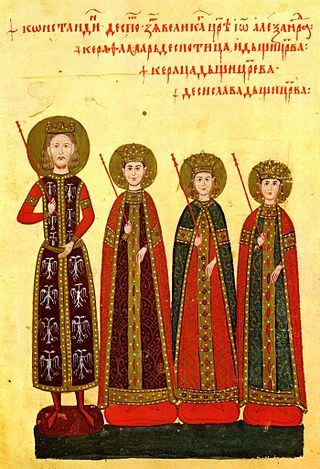
Konstantin (Kostadin) Dejanović or Konstantin Dragaš was a Serbian magnate that ruled a large province in eastern Macedonia under Ottoman suzerainty, during the fall of the Serbian Empire. He succeeded his older brother Jovan Dragaš, who had been an Ottoman vassal since the Battle of Maritsa (1371) which had devastated part of the Serbian nobility. The brothers had their own government and minted coins according to the Nemanjić style. His daughter Jelena married Byzantine Emperor Manuel II Palaiologos in 1392. He fell at the Battle of Rovine, serving the Ottomans against Wallachia, fighting alongside Serbian magnates Stefan Lazarević and Marko Mrnjavčević.

The Battle of Vaslui was fought on 10 January 1475, between Stephen III of Moldavia and the Ottoman governor of Rumelia, Hadım Suleiman Pasha. The battle took place at Podul Înalt, near the town of Vaslui, in Moldavia. The Ottoman troops numbered up to 120,000, facing about 40,000 Moldavian troops, plus smaller numbers of allied and mercenary troops.
Constantine II ruled as emperor (tsar) of Bulgaria in Vidin from 1397 to 1422. He was born in the early 1370s, and died in exile at the Serbian court on 17 September 1422. Constantine II claimed the title Emperor of Bulgaria and was accepted as such by foreign governments, but he is often omitted from listings of rulers of Bulgaria.
The Battle of Karanovasa took place on 10 October 1394 between the Wallachian army led by Voivode Mircea cel Bătrân against an Ottoman invasion led by Sultan Bayezid I. This battle is sometimes confused with the later Battle of Rovine between the same combatants, and which took place also along the valley of the Argeș River.

Moravian Serbia, the Principality of Moravian Serbia or the Realm of Prince Lazar are the names used in historiography for the largest and most powerful Serbian principality to emerge from the ruins of the Serbian Empire (1371). Moravian Serbia was named after Morava, the main river of the region. The independent principality in the region of Morava was established in 1371, and attained its largest extent in 1379 through the military and political activities of its first ruler, prince Lazar Hrebeljanović. In 1402 it was raised to the Serbian Despotate, which would exist until 1459.

The Hungarian–Ottoman wars were a series of battles between the Ottoman Empire and the medieval Kingdom of Hungary. Following the Byzantine Civil War, the Ottoman capture of Gallipoli, and the decisive Battle of Kosovo, the Ottoman Empire was poised to conquer the entirety of the Balkans. It also sought and expressed desire to expand further north into Central Europe, beginning with the Hungarian lands.

The military history of Romania deals with conflicts spreading over a period of about 2500 years across the territory of modern Romania, the Balkan Peninsula and Eastern Europe and the role of the Romanian military in conflicts and peacekeeping worldwide.
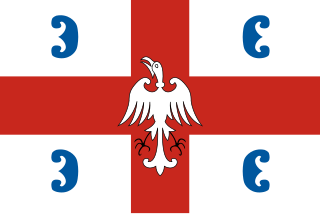
The Lordship of Prilep, also known as the Realm of King Marko or the Kingdom of Prilep, was one of the successor-states of the Serbian Empire, covering mainly the southern regions of the former empire, corresponding to western parts of present-day North Macedonia. Its central region of Pelagonia, with the city of Prilep, was held by lord Vukašin Mrnjavčević, who in 1365 became Serbian king and co-ruler of Serbian emperor Stefan Uroš V (1355–1371). After king Vukašin died at the Battle of Maritsa in 1371, the realm was obtained by his son and designated successor Marko Mrnjavčević, who took the title of Serbian king. At that time, capital cities of the Serbian realm were Skopje and Prizren, but during the following years king Marko lost effective control over those regions, and moved his residence to Prilep. He ruled there until his death in the Battle of Rovine in 1395. By the end of the same year, the Realm of late King Marko was conquered by the Ottoman Empire.

The fall of the Serbian Empire was a decades-long process in the late 14th century. Following the death of the childless Emperor Stefan Uroš V in 1371, the Empire was left without an heir and the magnates, velikaši, obtained the rule of its provinces and districts, continuing their offices as independent with titles such as gospodin, and despot, given to them during the Empire. This period is known as the dissolution or the beginning of the fall of the Serbian Empire.

The medieval fortress of Turnu is located in the southern part of Turnu Măgurele at a distance of 3 km from the city and 1 km from the confluence of the Olt and Danube rivers in today's Romania. The fortress is documented during the reign of Mircea the Elder (1394) and was built on the Danube line for the defense of Wallachia against the Turkish peril. At the end of the reign of Mircea the Elder, under unclear circumstances, it came under Ottoman occupation to return to the possession of Wallachia only in 1829 when it was burned and demolished.















